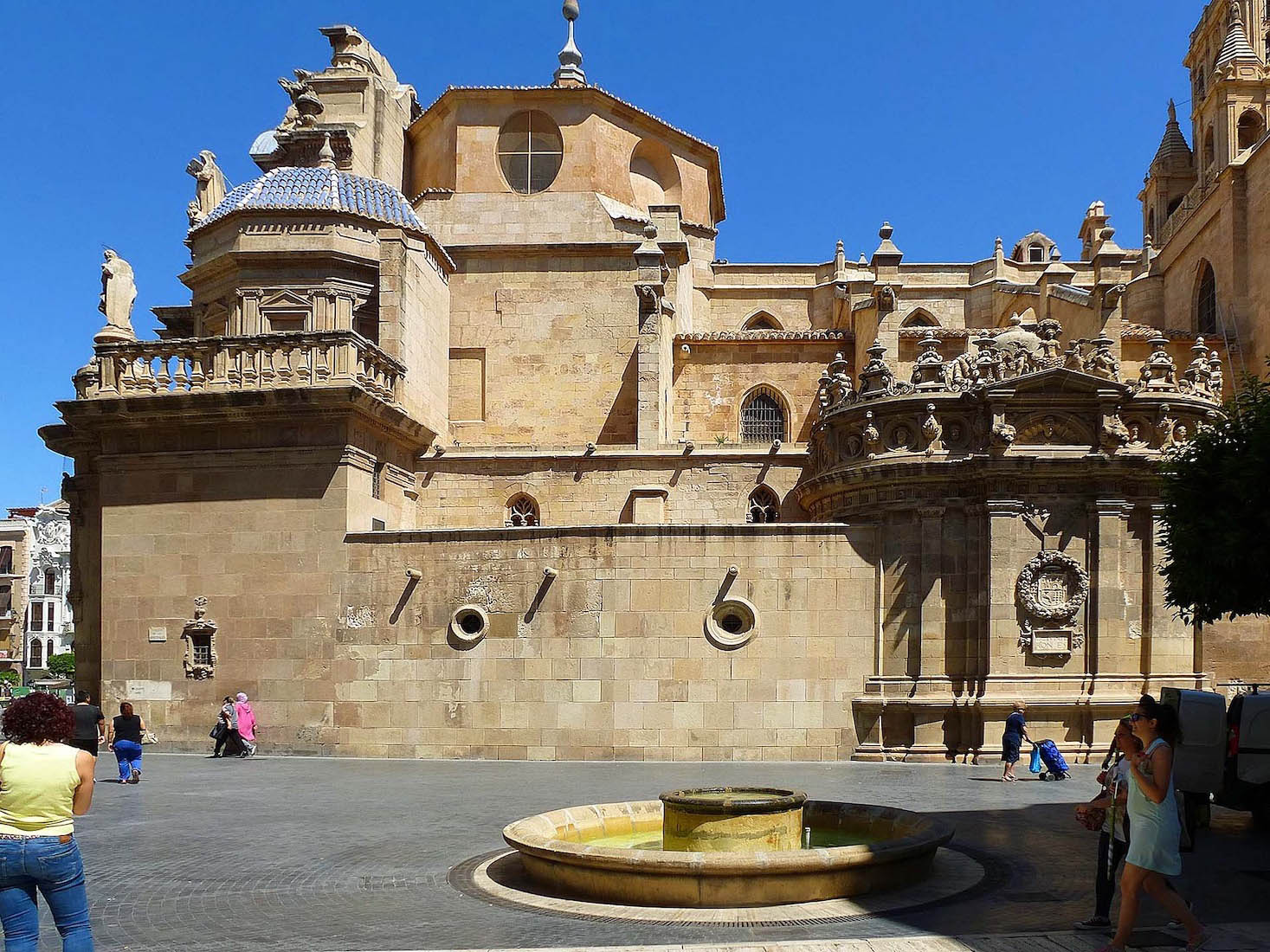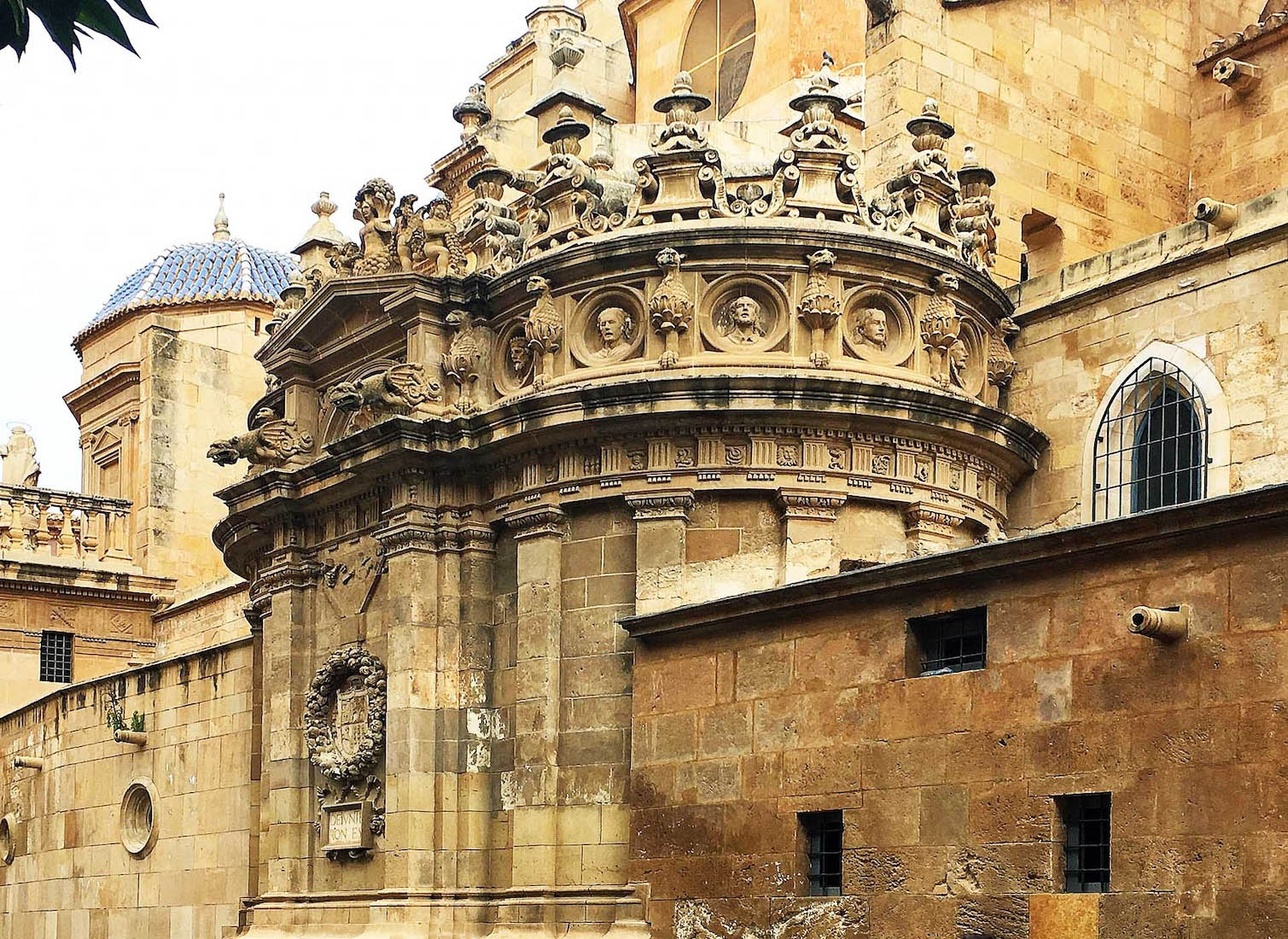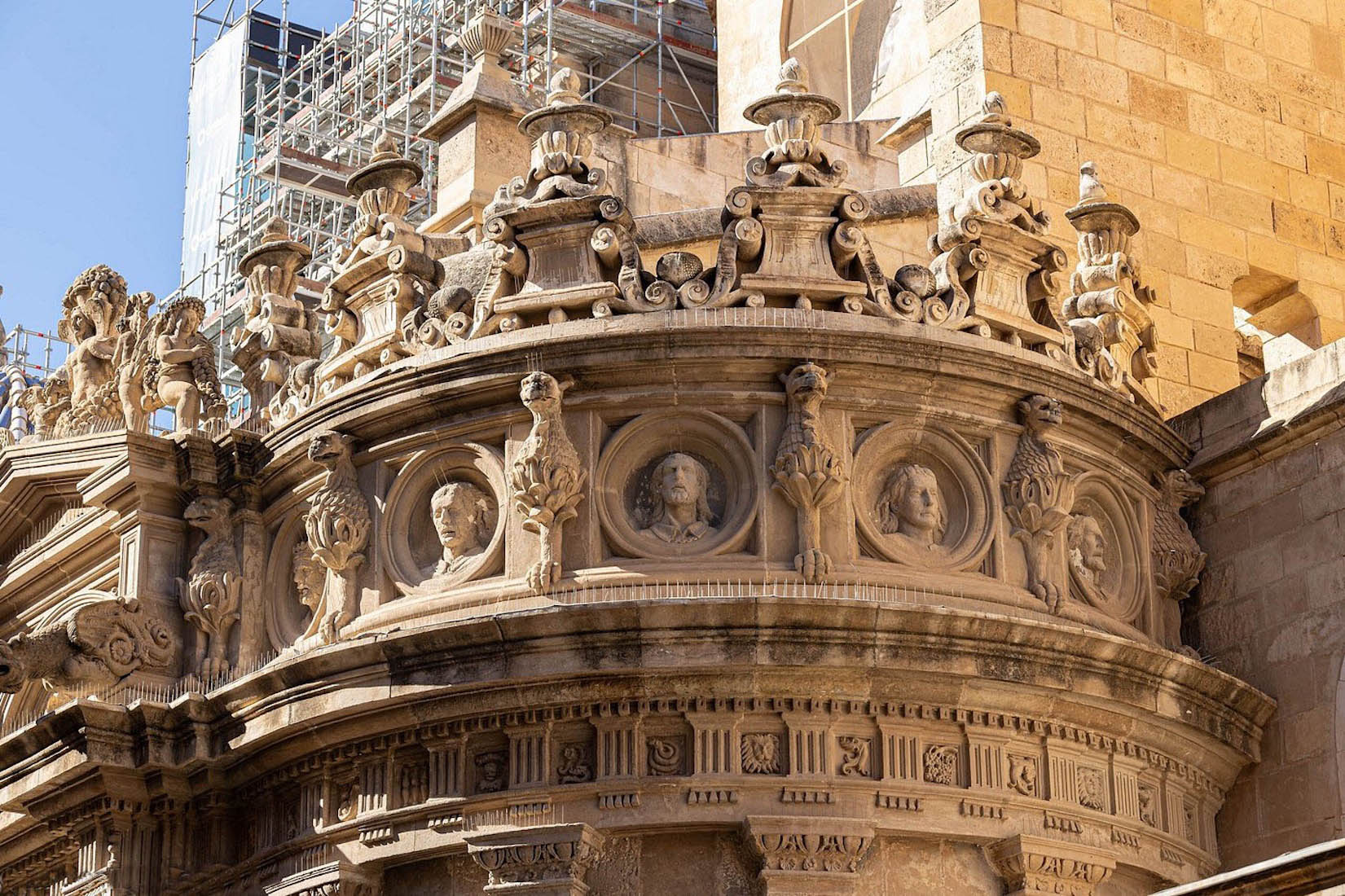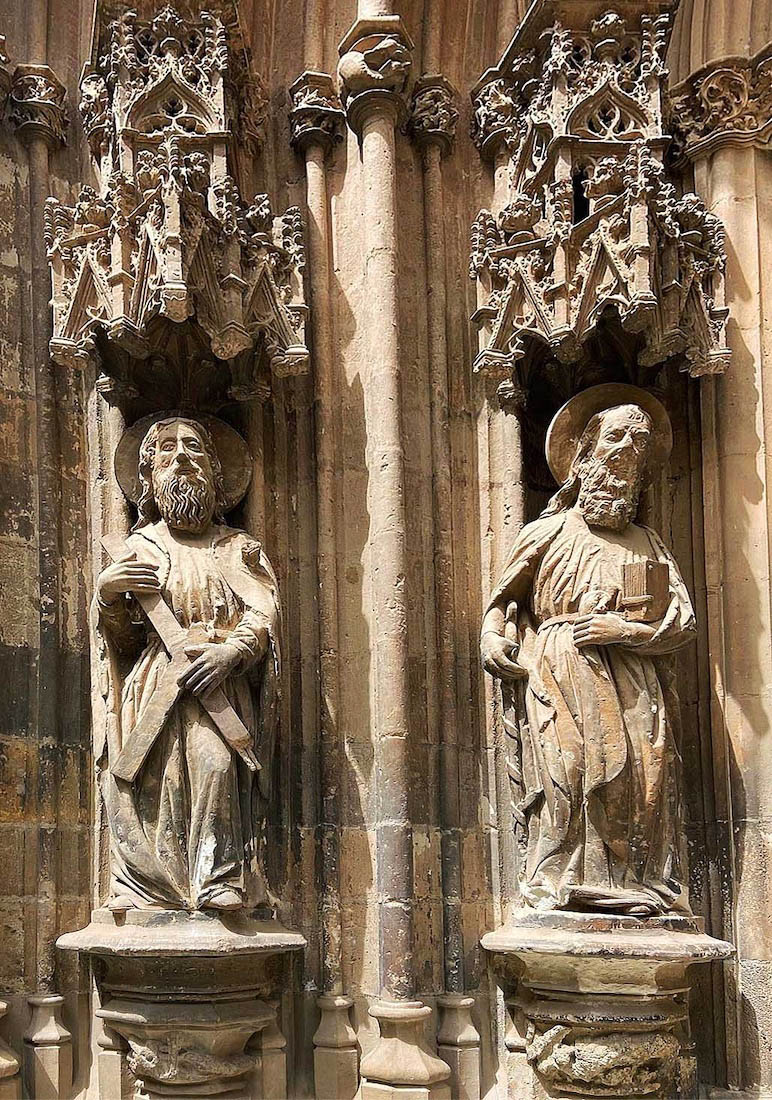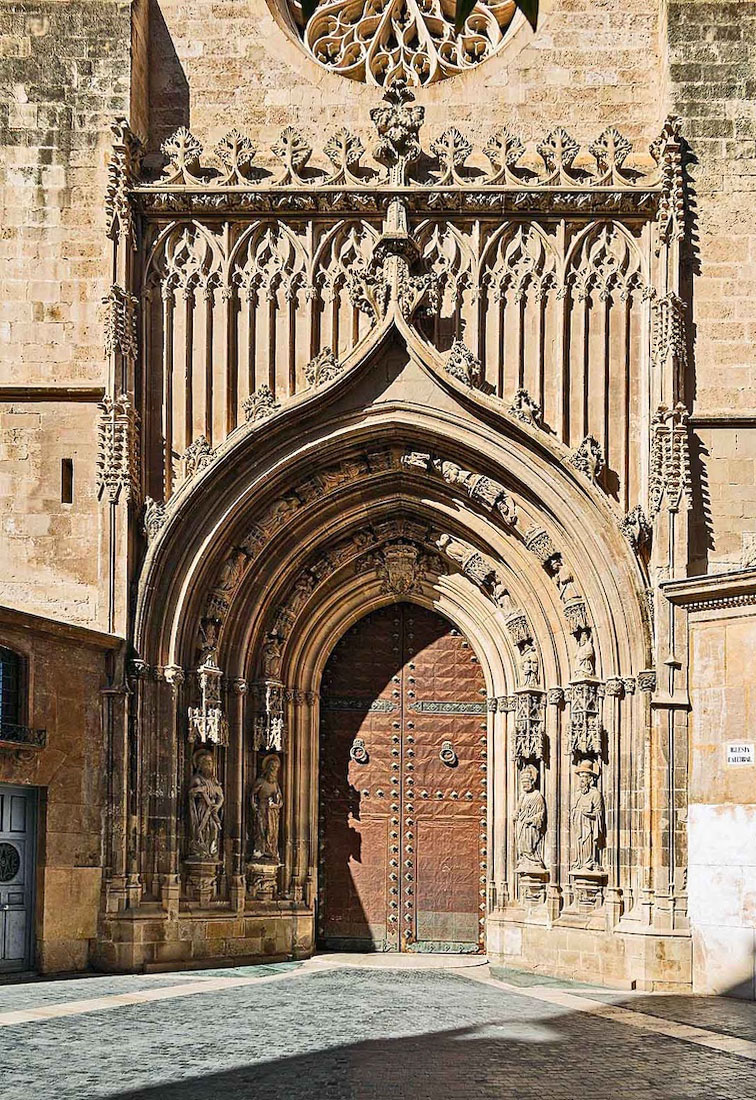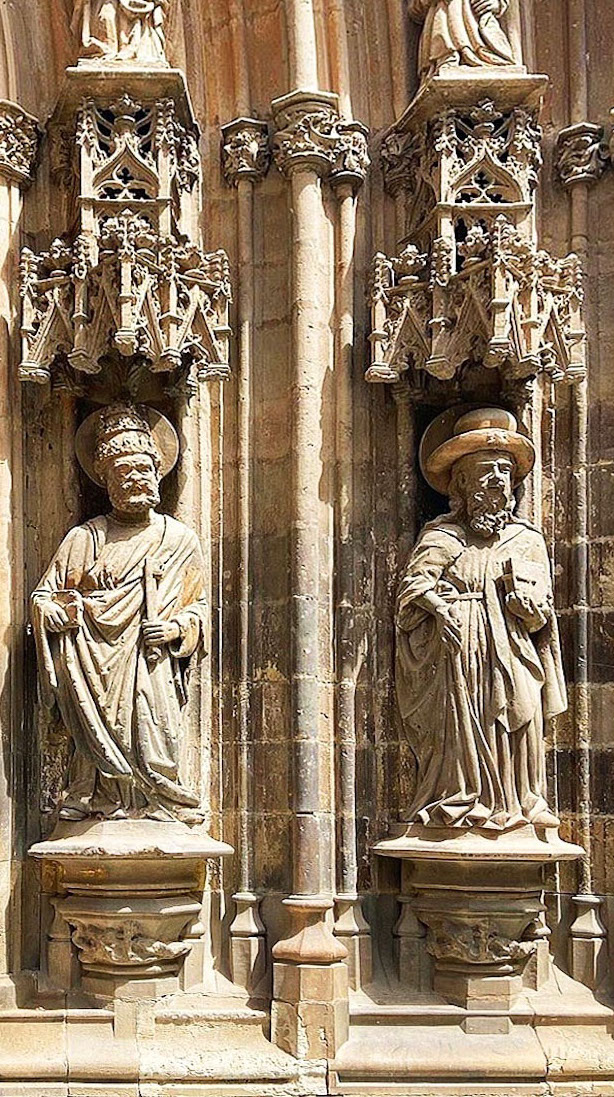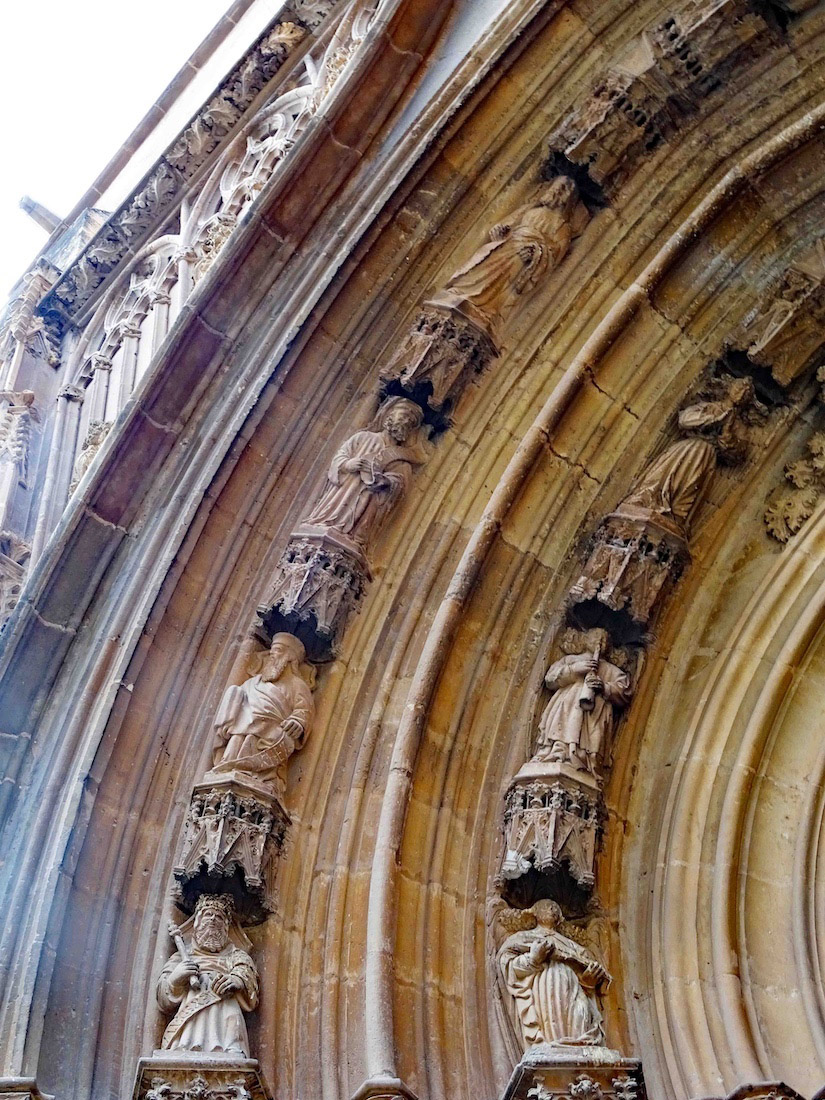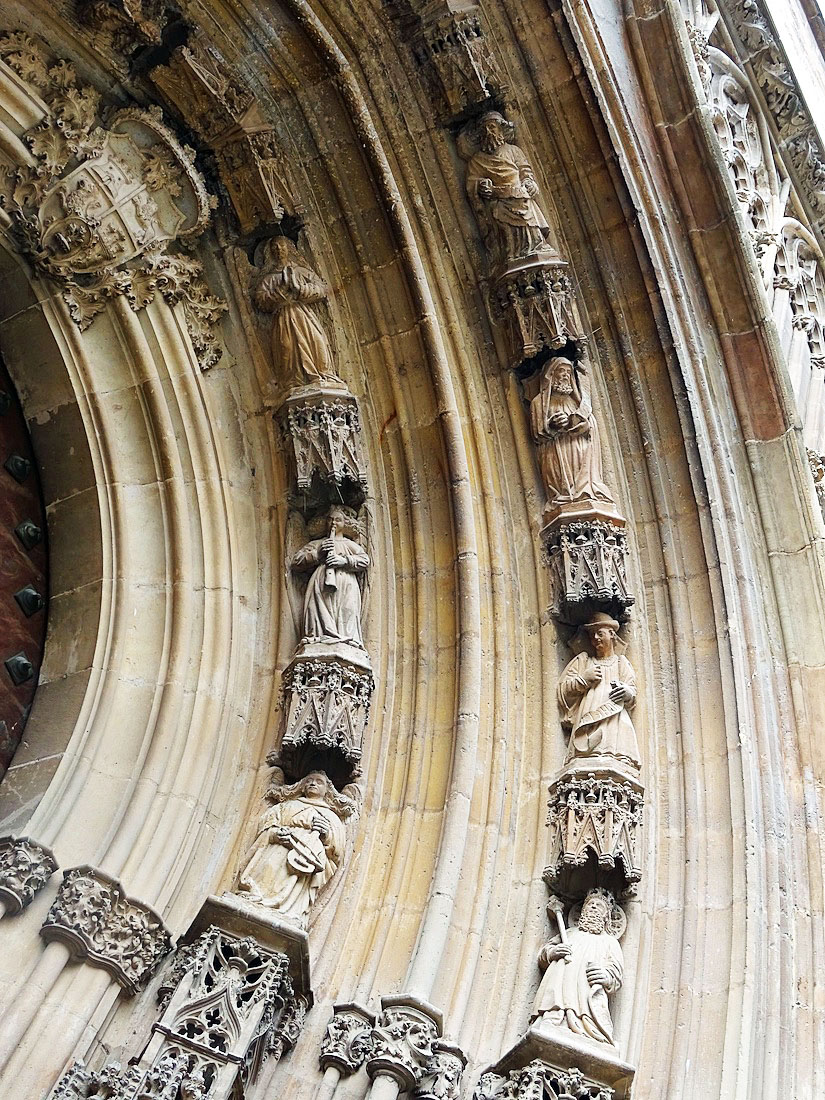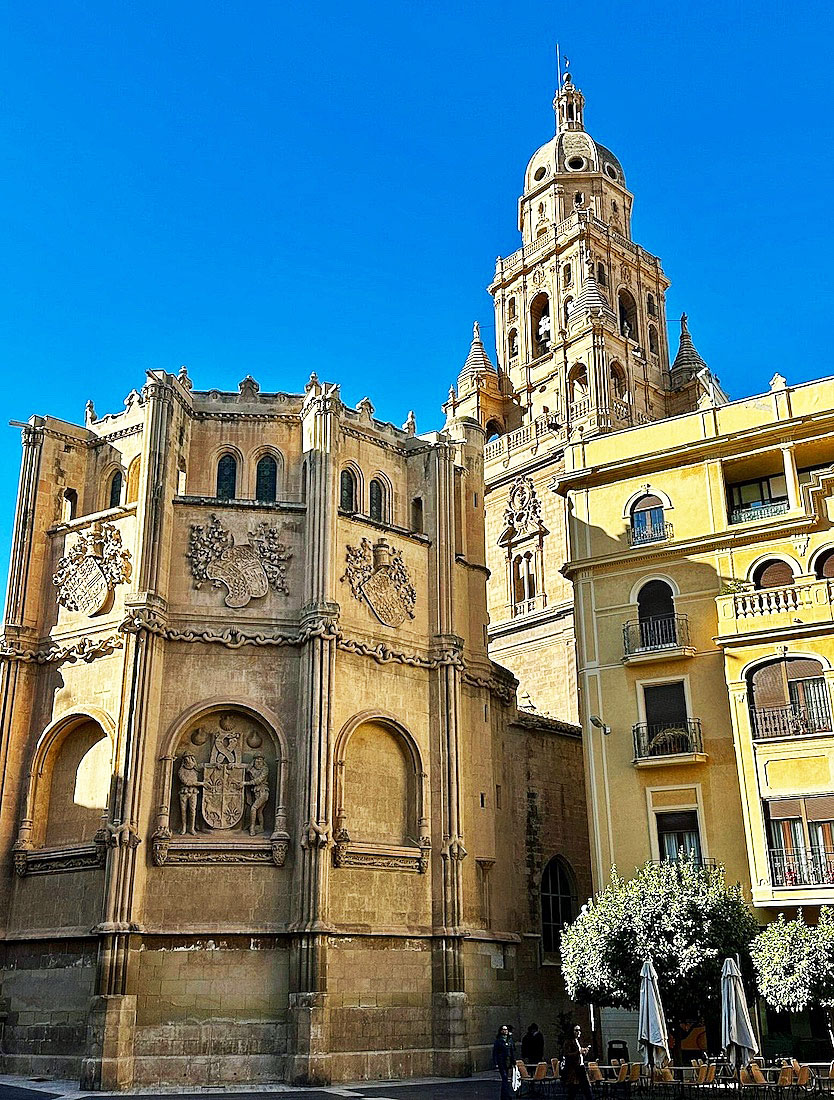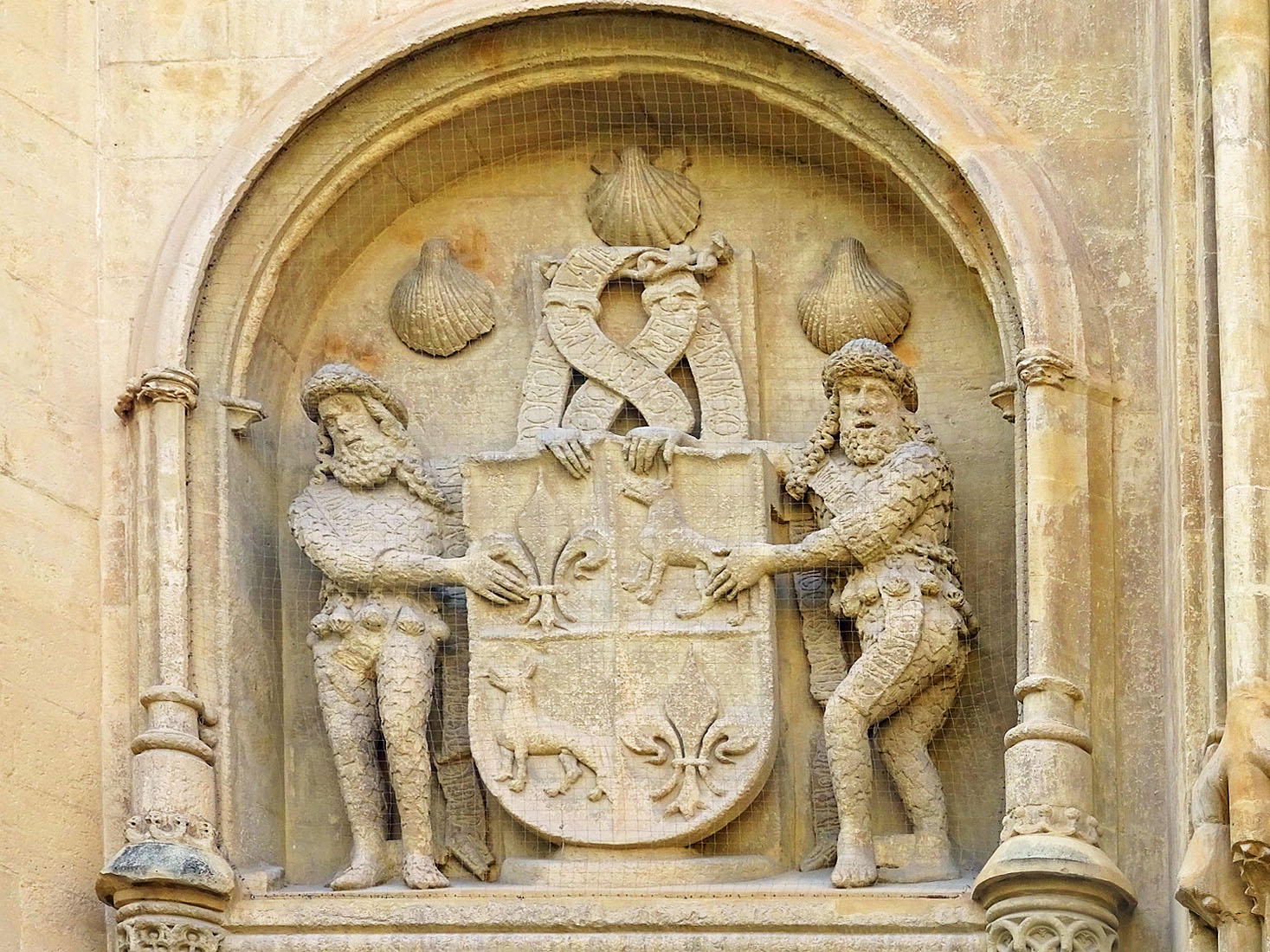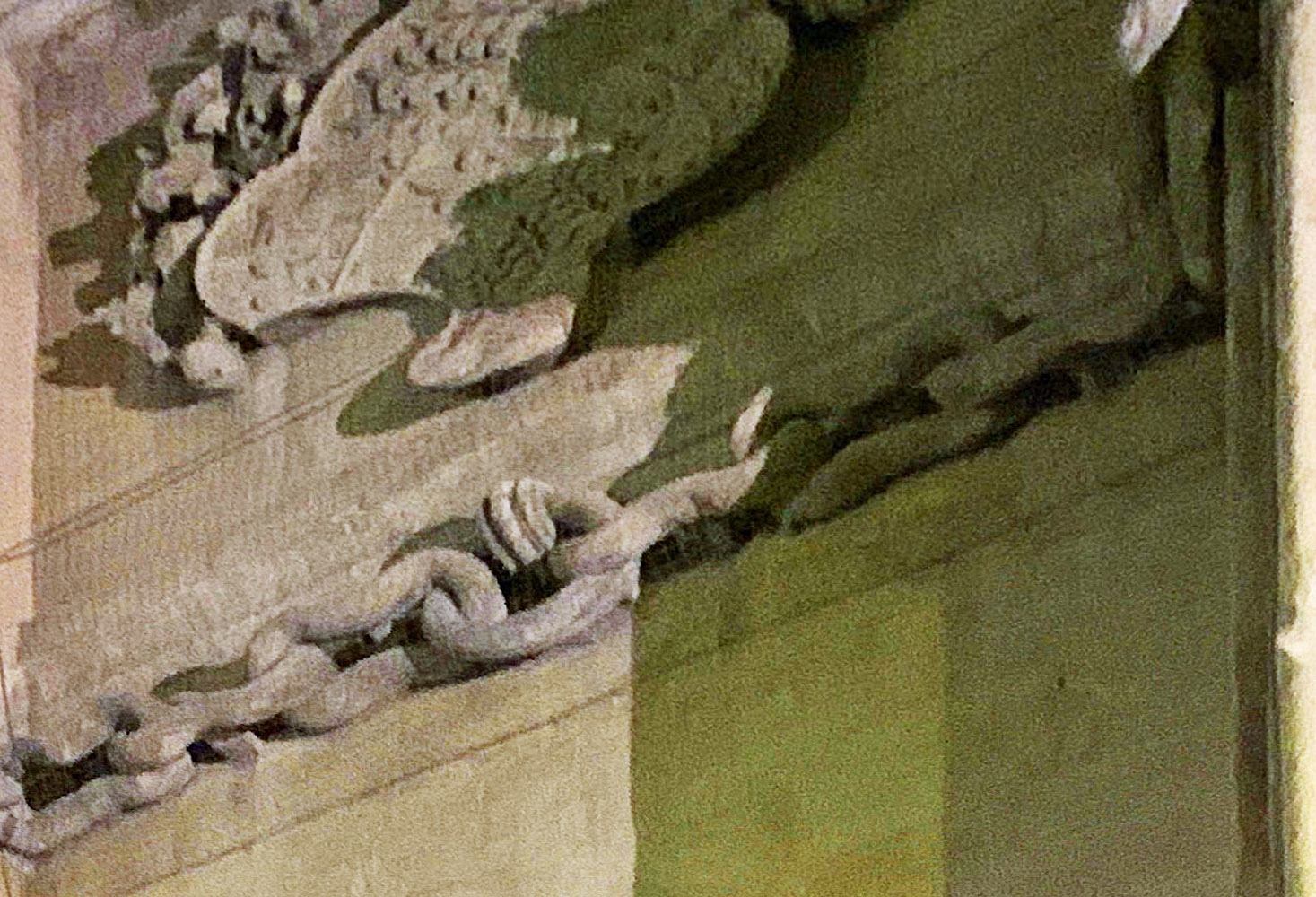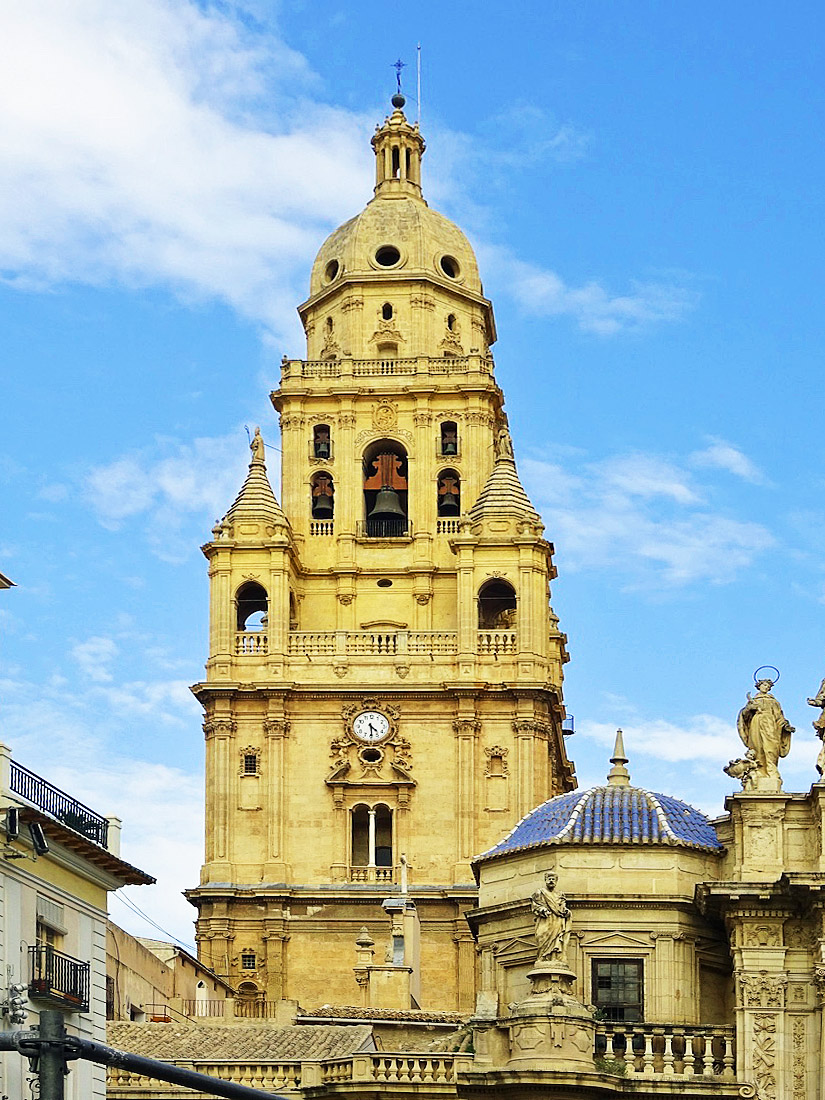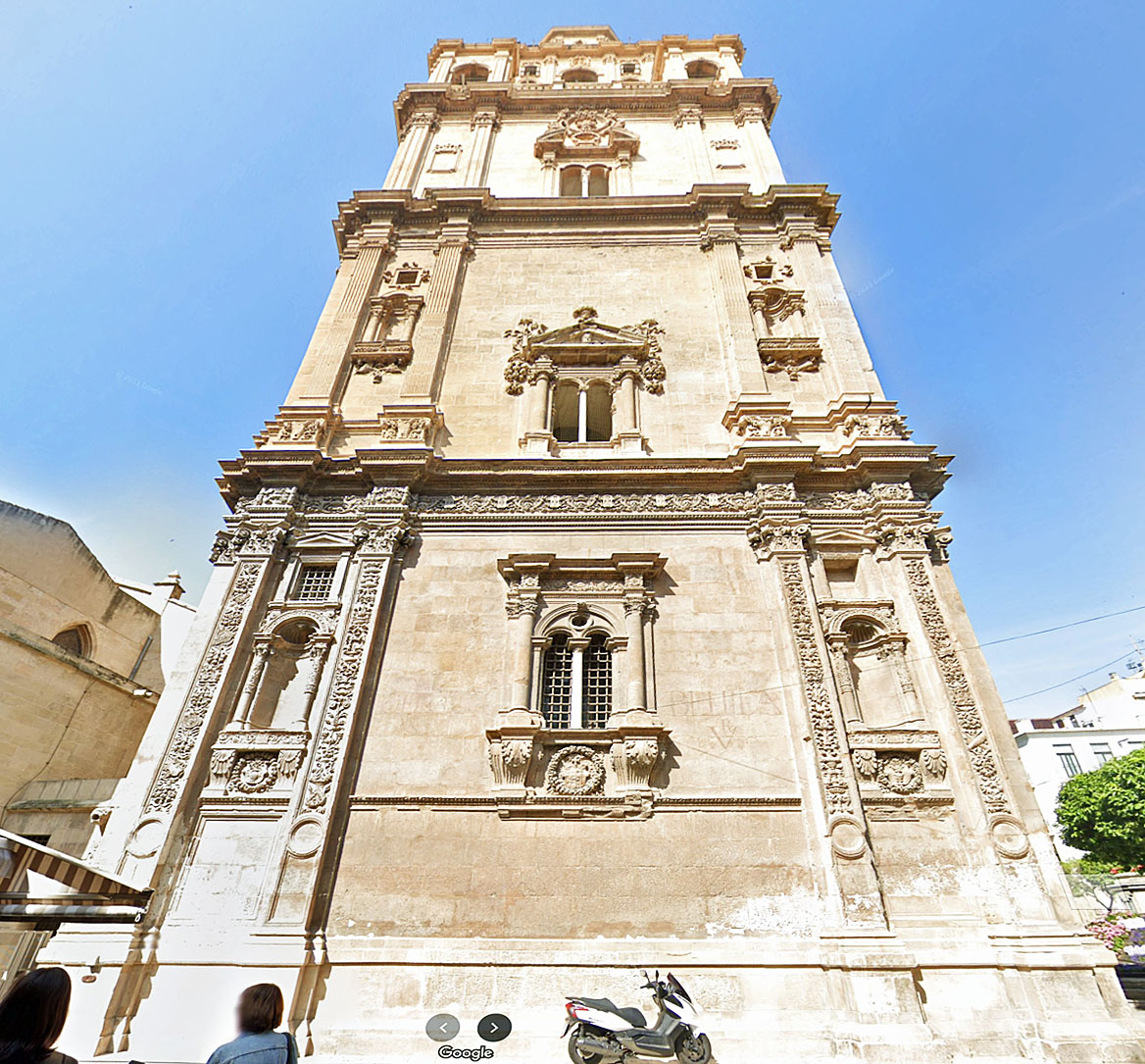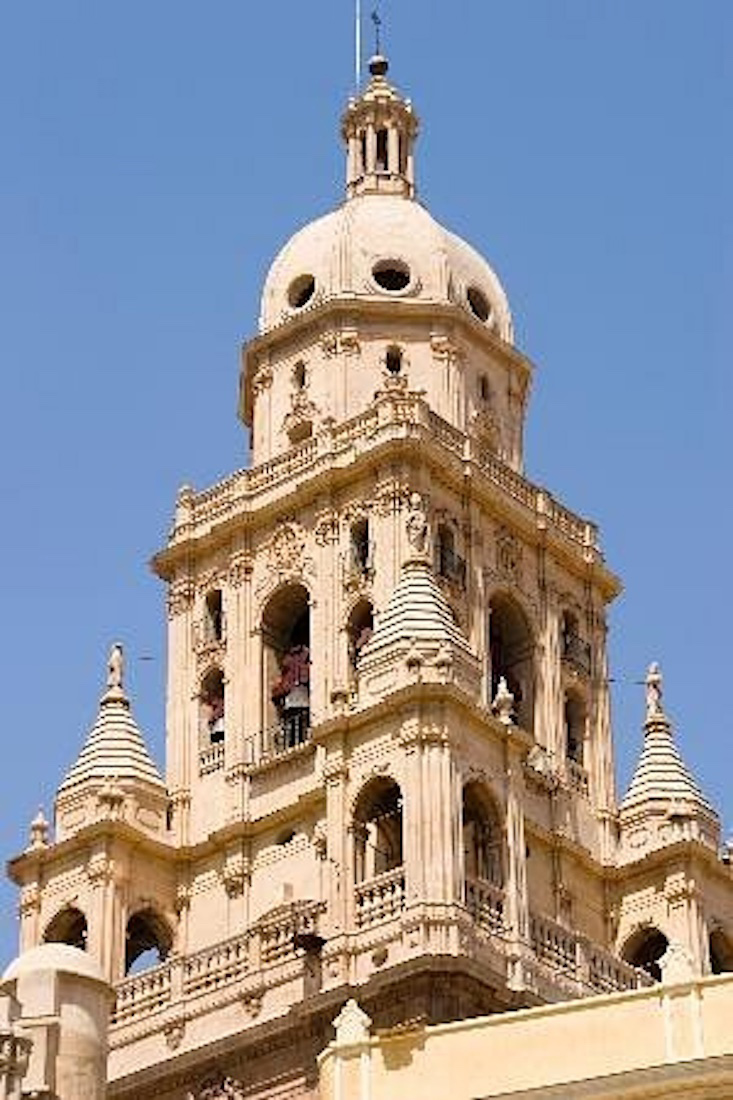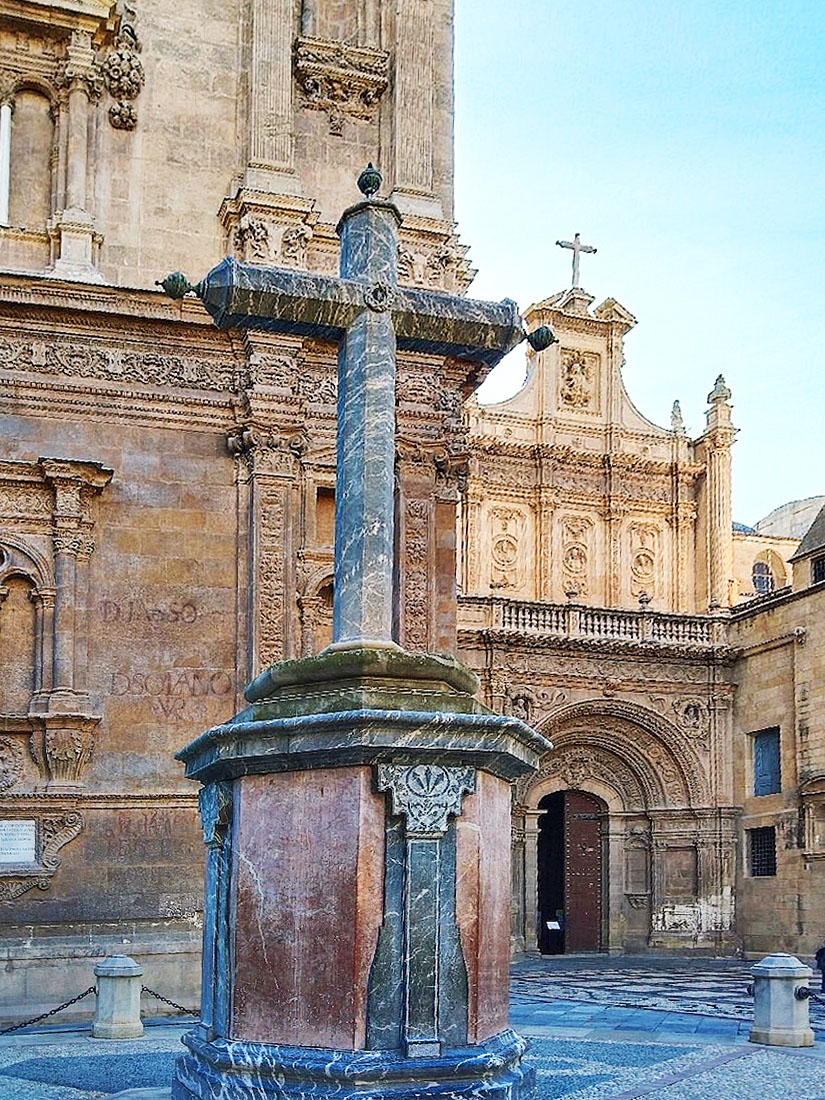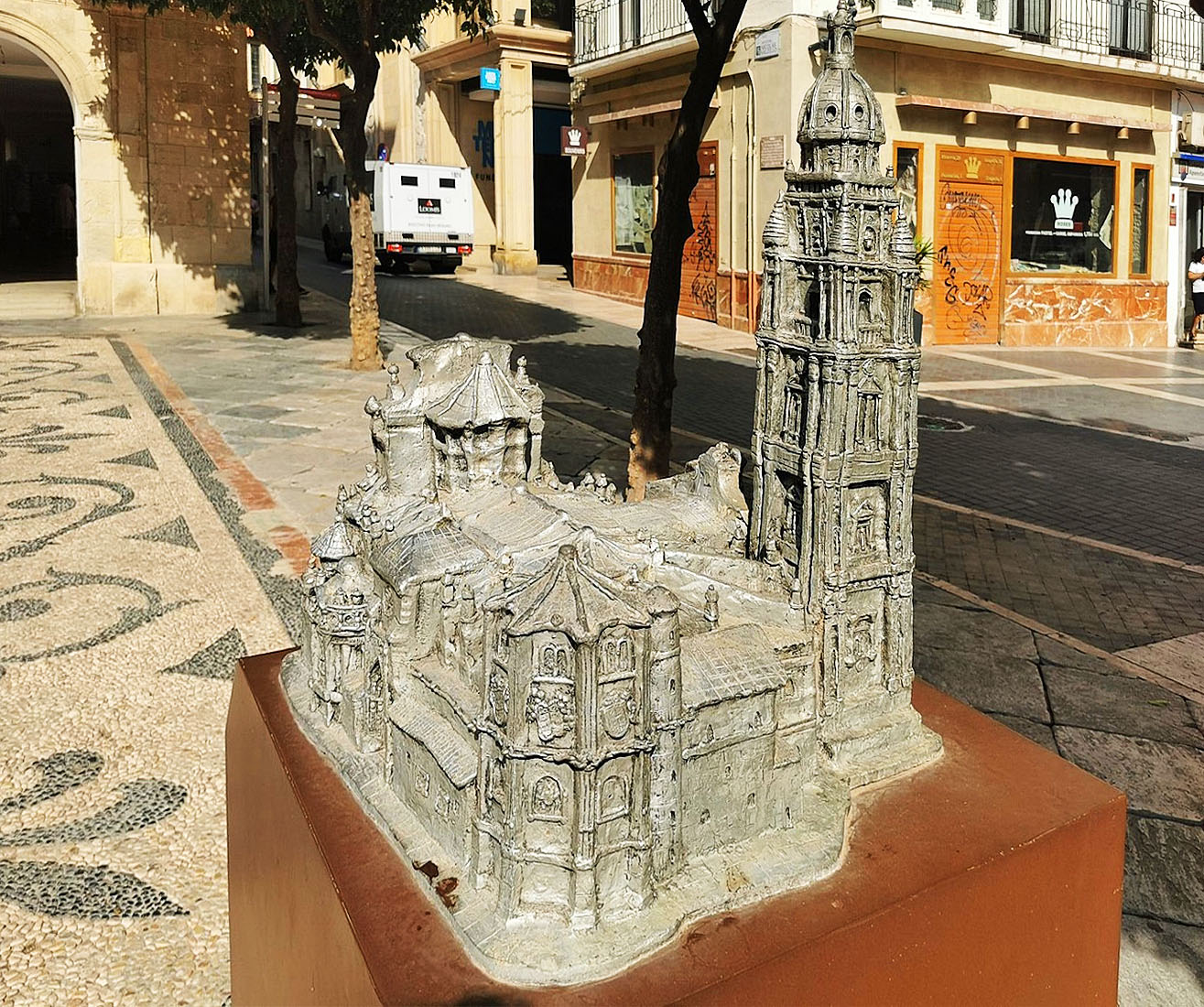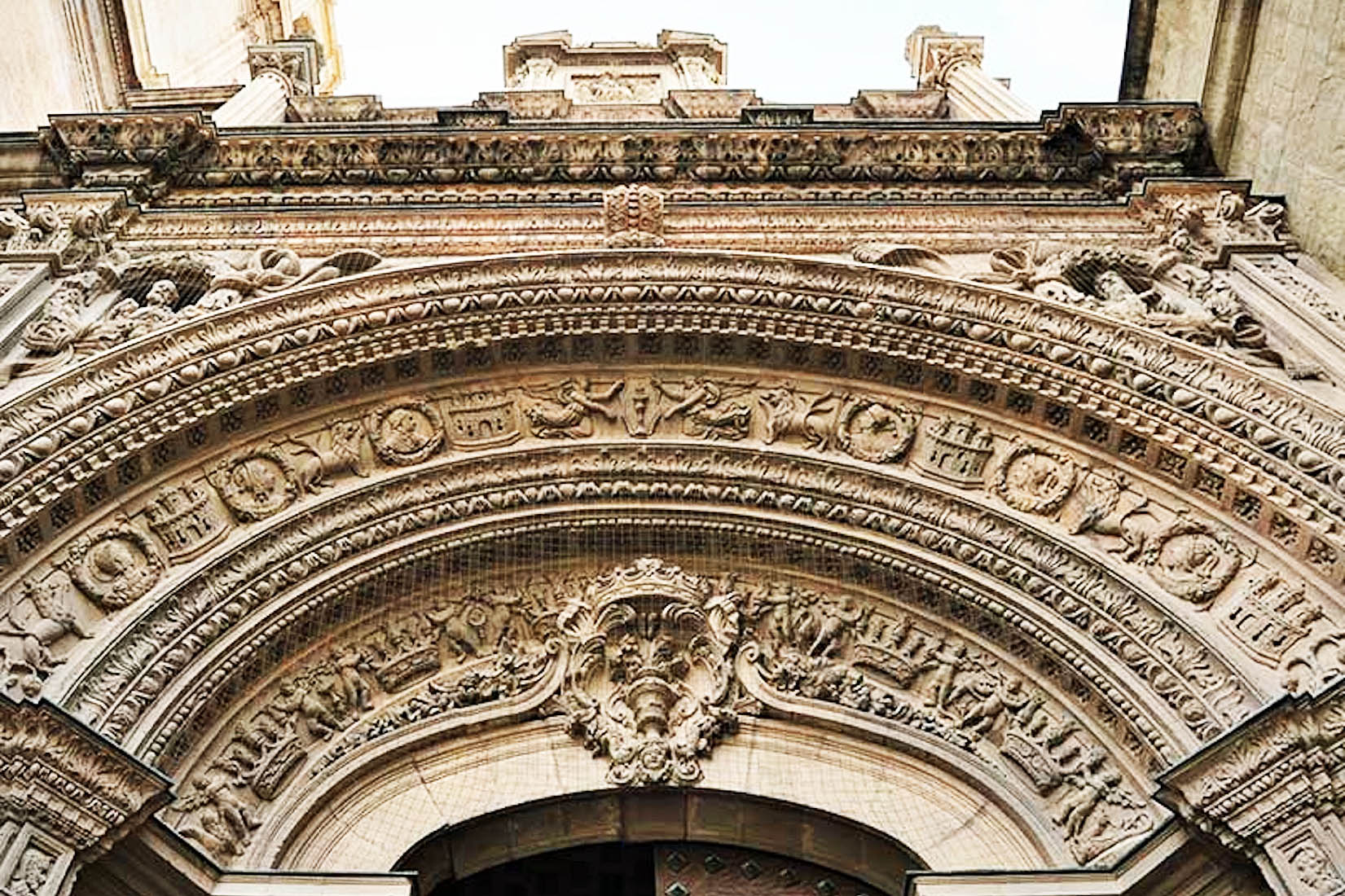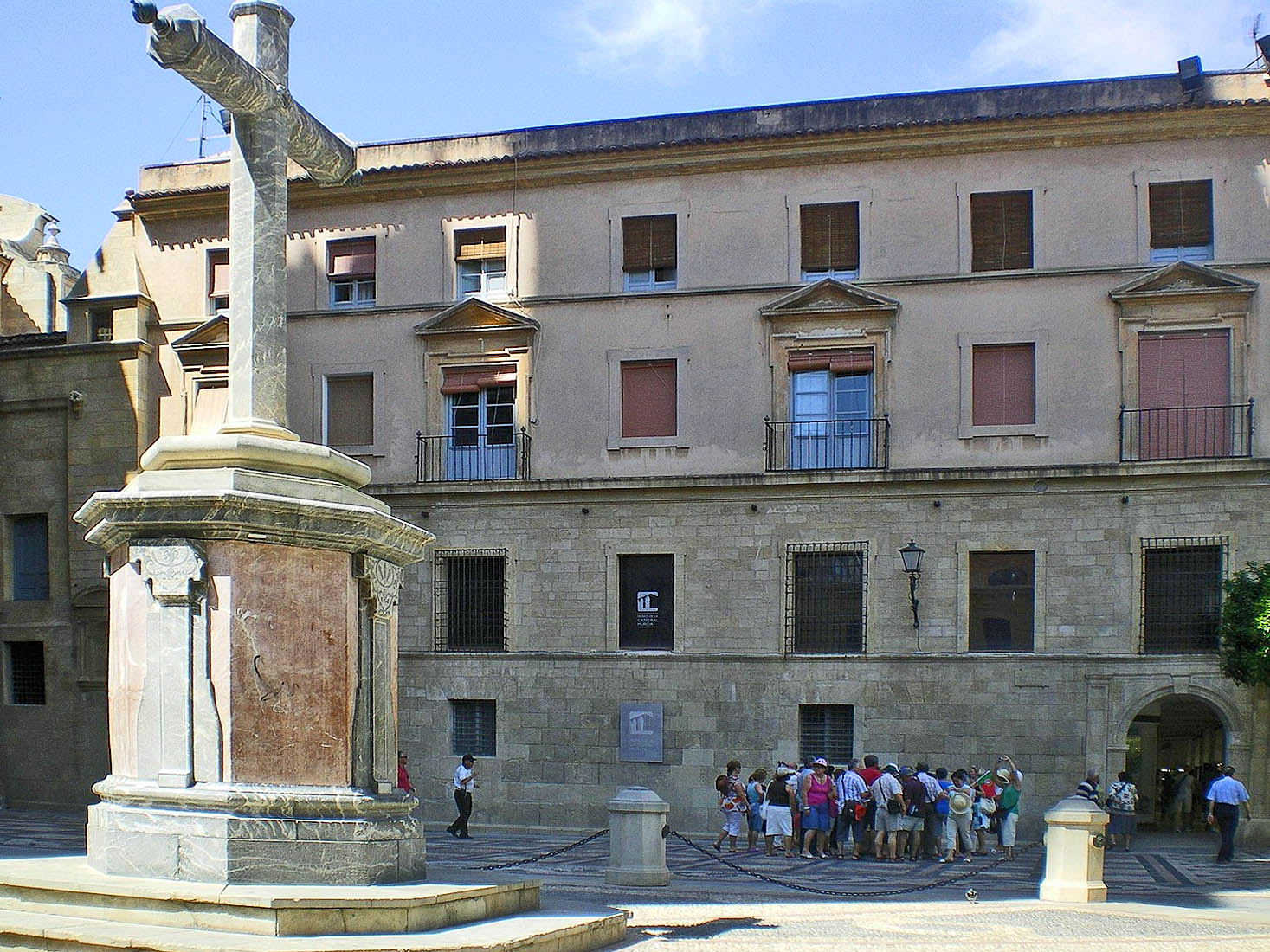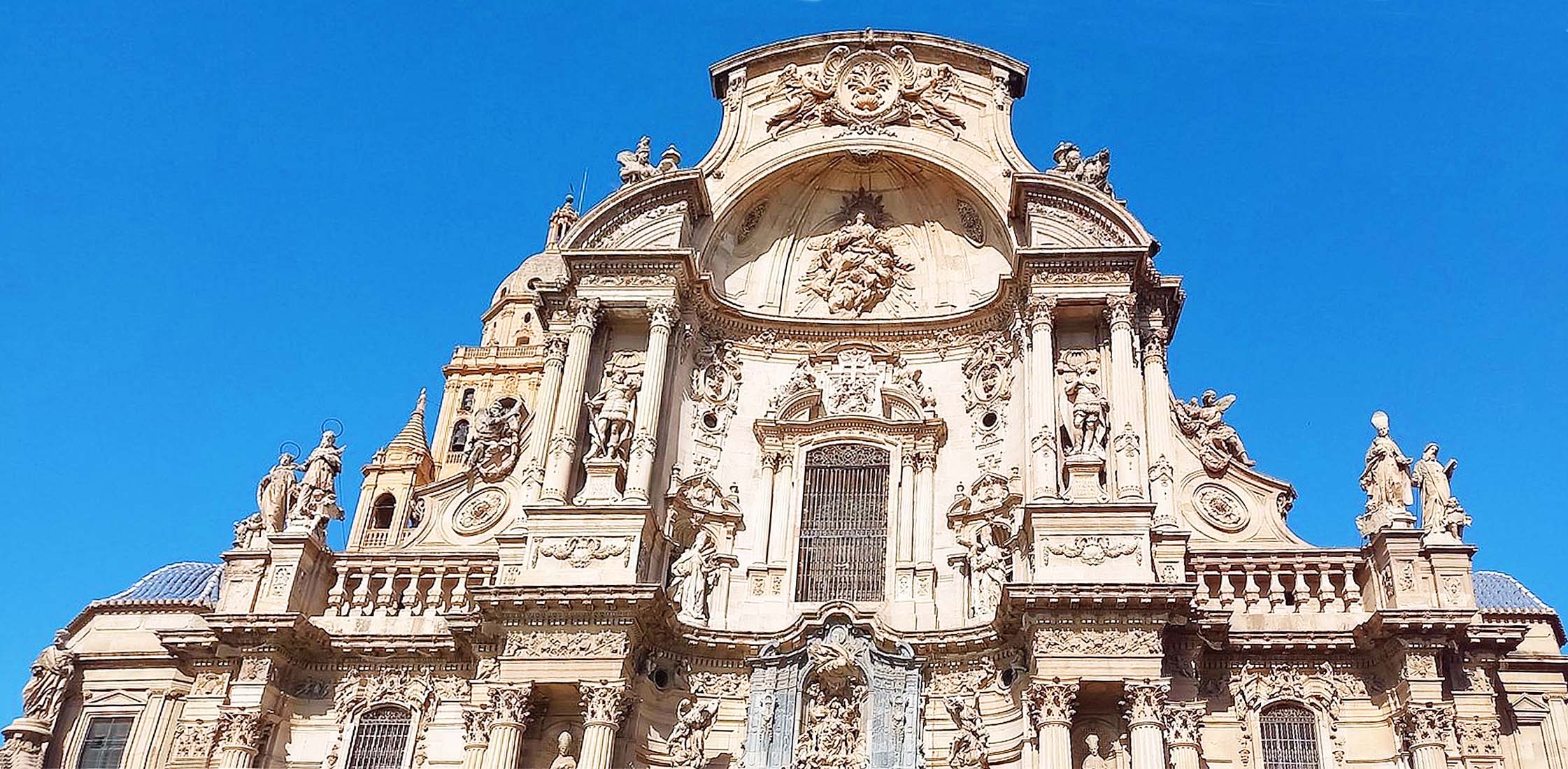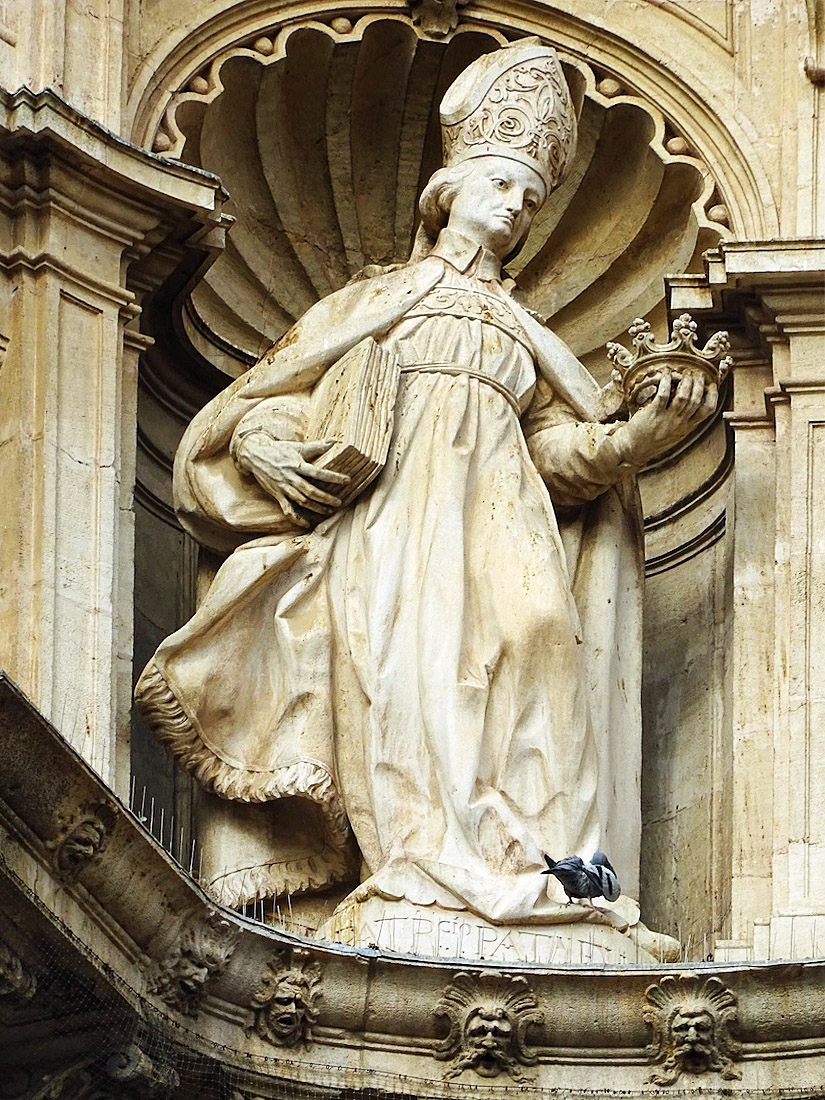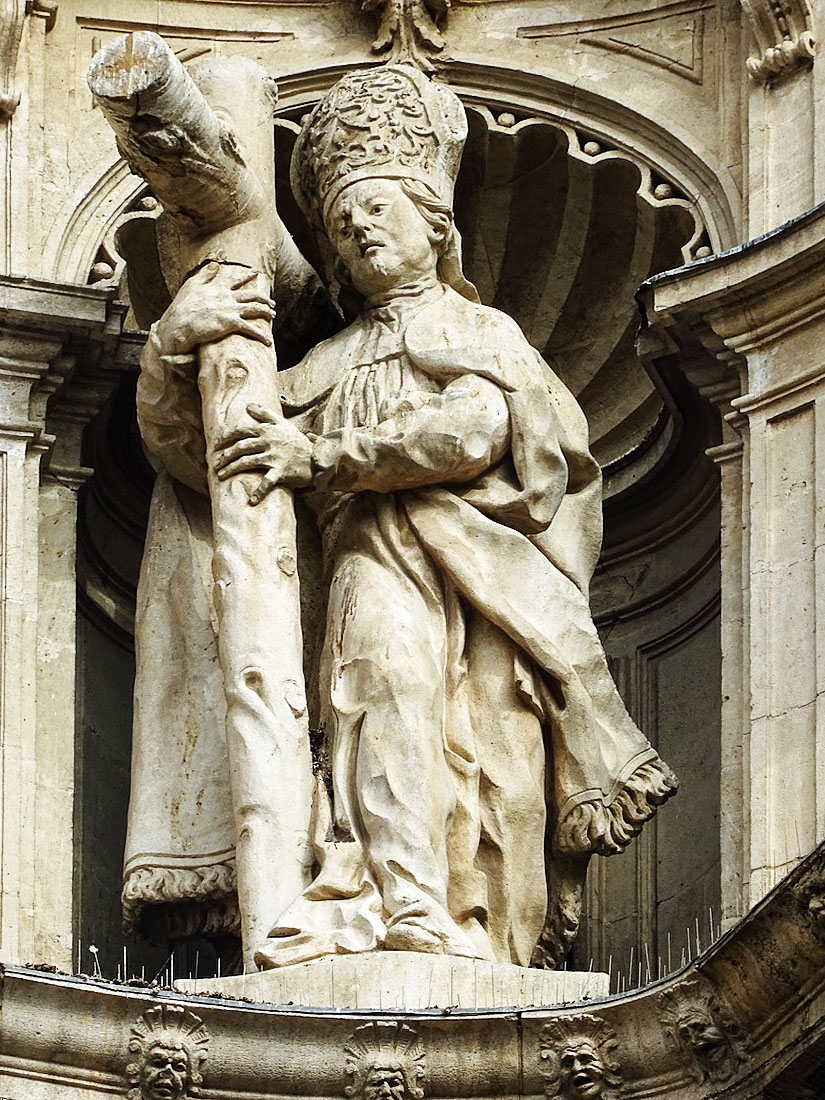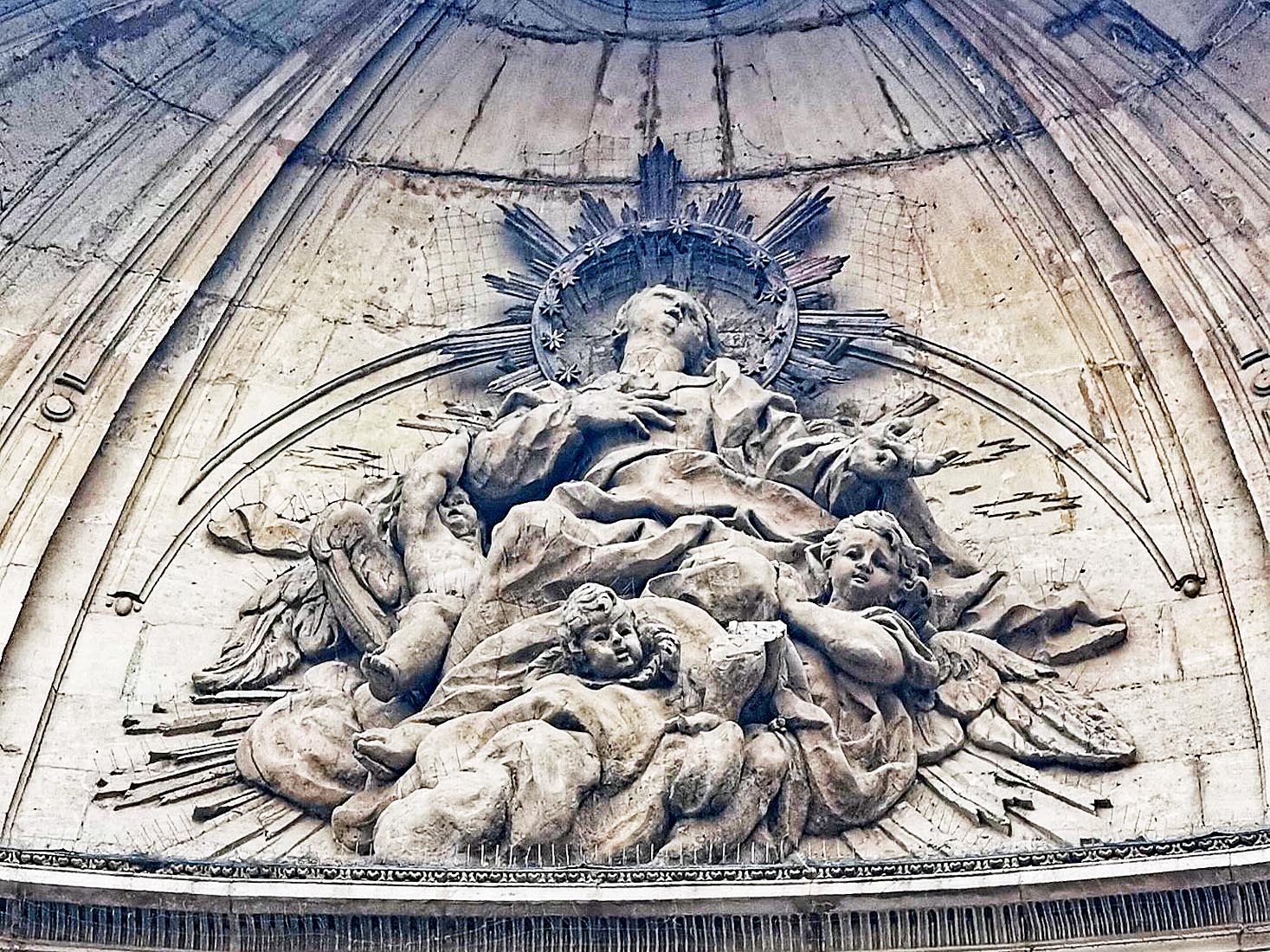EXTERIOR

Murcia is a city of around half a million people in the southeast of Spain. Murcia Cathedral is about a kilometre north of the Murcia del Carmen railway station – an easy walk, and just north of the Segura River. We find ourselves standing in the Plaza of Cardinal Belluga, facing the amazing baroque West face. The façade has a lovely symmetry with three entry doors, and a great deal of intricate baroque decoration. Behind at left is a beautiful bell tower. We shall examine the West face in more detail shortly, but first we explore around the outside, following around to the right. [Photo Credit: Fernando] INDEX
2. FOLLOWING SOUTH TA
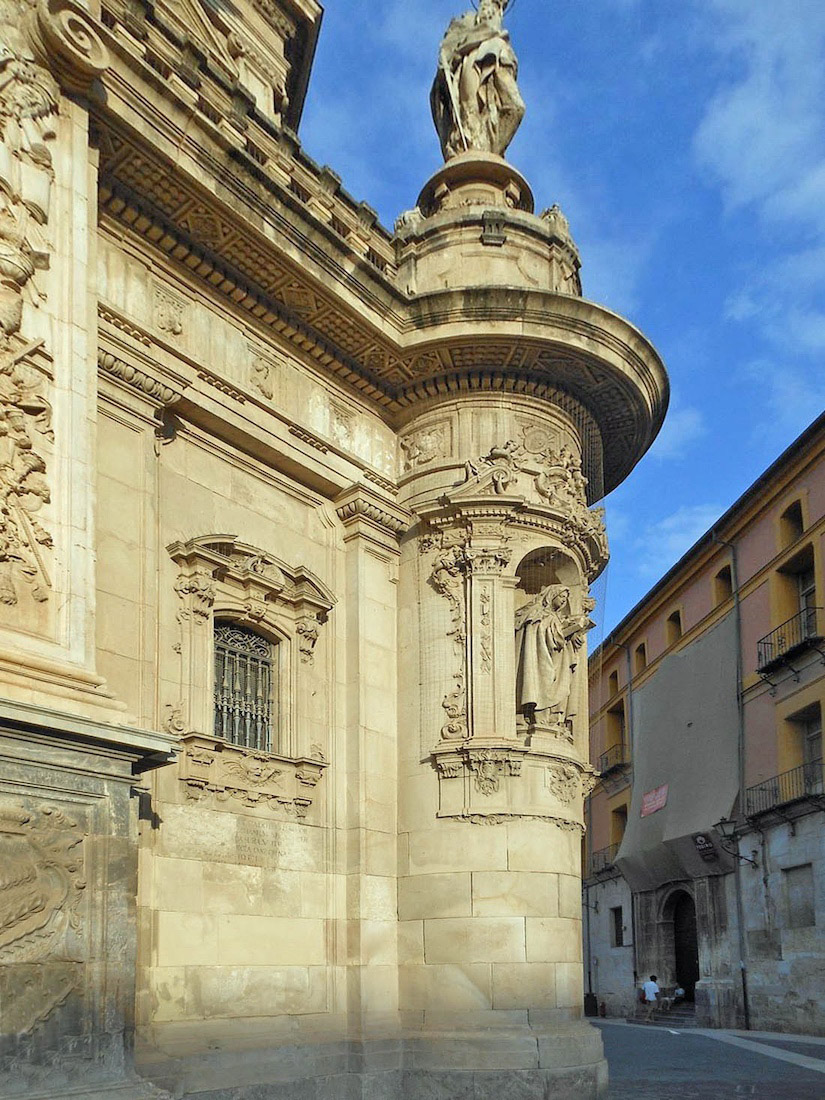
A narrow roadway leads us round below a robed figure studying the scriptures. [Photo Credit: José Maria P]
3. SOUTHWEST CORNER Wiki
Almost immediately we come to a little plaza with a non-functioning fountain. Looking up, at left we see some of the West face figures, and a small blue dome. The wall in front of us is quite plain – almost industrial! And then to the right is the protruding wall of the Junterones Chapel with some more incredible decoration. [Photo Credit: chrisloup]
4. THE JUNTERONES CHAPEL Wiki Wiki
The Junterones Chapel is more fully known as the Chapel of Gil Rodríguez de Junterón. The chapel is one of the most valued and esteemed of the Spanish Renaissance. In the top view, we see the wall extending beyond the chapel to the South transept, with the bell tower rising up behind. [Photos Credit: PiotrMig]
5. DETAILED CHAPEL VIEW TA
Outside, the chapel is capped by a ring of floral vases. In the band below, front centre two dragons (gargoyles?) emerge, and a small bust of Julius II sits between. The band extends to the sides with heads looking out from circular frames. The two crowned heads nearest the centre are Ferdinand the Catholic (right) and Charles V (left). We continue walking up the Apostles Street to the South transept. [Photo Credit: MarcusHurley]
6. SOUTH TRANSEPT DOORWAY TA TA TA
A short stretch of plain wall, and we come to the South transept with its ornate recessed doorway – the Apostles Doorway. We know that this is the only entrance from the 15th century still preserved at the Cathedral. There are two apostles on either side: at left St Andrew and St Paul, and at right St James and St Peter. [Photos1,3 Credit: Nerea ] [Photo2 Credit: MarcusHurley ]
7. DOORWAY DETAILS fjg (x3)
At the top of the door is a shield honouring Queen Isabella II, and various Old Testament prophets and kings appear on the arches above, along with musical angels. High above the door is the Cathedral’s only rose window.
8. SOUTH WALL EAST Wiki
We continue following along the Apostles Street. I find a curious contrast between this non-de-script wall and the amazing West façade! [Photo Credit: IVAN PEÑALVER QUILES ]
9. THE VÉLEZ CORNER CHAPEL TA fjg TA
There is a nice little plaza at the Southeast corner of the Cathedral (The Plaza of the Apostles). From here we can look back at the impressive Vélez Chapel – a highlight of the Cathedral. This is in fact a funeral chapel from the end of the 15th century. It was founded in 1490 by Juan Chacón, Governor of the Kingdom of Murcia and finished in 1507 by his son Pedro Fajardo, the first Marquis of Vélez. Created in a flamboyant Gothic style, it is one of only three chapels in Spain created in this style. We shall see the lavish interior later!
There is a story about the 90 - link chain. The legend says that the chains were built by a beggar who bragged to the Marquis of Vélez that he was a great sculptor and that he would make the chains in exchange for asylum. He was told that if the Marquis didn’t like his work then he would die, but if he did like it then he would live a peaceful life. When the sculptor had finished everybody was surprised by the great work of art he had created. The beggar later decided to move on to somewhere else, but in fear of him producing more beautiful work for another land, his hands were cut off so that he couldn’t ever build another, and his tongue was cut out so that he couldn’t ever tell anyone how to make it. Nice story! [Photo1 Credit: Ramón ] [Photo3 Credit: Clomandojo ]
10. BELL TOWER fjg TA GSV
From the plaza, we follow around the narrow Oliver Street where we get a good view of the bell tower. The bell tower is 90 metres tall – 95 metres with the weather vane. It was built in several stages, the first two parts are Renaissance style, designed by Jacobo Florentino and Jerónimo Quijano respectively. Following a two-century interruption to building work, José López took charge of the continuation of building midway through the 18th century with the Baroque sections of the clock and the bell tower. ... [Photo2 Credit: AGM9 ]
11. DESIGN FEATURES TA Wiki TA
... This architecture was finished off in a neoclassical style at the end of the 18th century, with the dome and the lantern, under the management of Ventura Rodríguez. The words above the bells translate to ‘St Mary is Peace’. [Photo1 Credit: Martin Garnham ] [Photo2 Credit: H Helmlechner ] [Photo3 Credit: JoseManuel ]
12. NORTH PLAZA CROSS TA
A little further on we come to the Plaza Hernandez Amores. A large cross stands here, and looking past the right of the cross we see the cathedral North door in the end of the North transept. Sometimes we might be lucky to see a beautiful array of flowers laid out around the cross. [Photo Credit: nancyenron ]
13. MODEL CATHEDRAL TA
A strip of decorated paving leads straight out from the North door of the Cathedral, and leads past this model. I have always found such models helpful, but this model is specifically designed for blind people to touch and feel what the Cathedral looks like. [Photo Credit: Vadim ]
14. NORTH DOOR Wiki TA
The North door is called ‘The Door of Chains’, although it is not altogether clear what the name refers to. The structure above the door has reliefs which feature the Catholic Monarchs accompanied by their daughter Joanna, Philip the Handsome and other figures of the Crown of Castile. On the spandrels of this arch (top corners), two large laurel wreaths feature the busts of St Peter and St Paul. [Photo1 Credit: chrisloup ][Photo2 Credit: Vadim]
15. NORTH DOOR CARVING MC MC
The ornamental top of the door was built at the end of the 18th century and ‘shows iconographies that are very beloved in the history of this Cathedral, such as the Nursing Madonna and the Saintly Brothers of Cartagena: Leander, Fulgentius and Isidore’.
16. CROSS AND MUSEUM WALL MC
The large Southwest corner of the Cathedral is taken up by the Cathedral Museum, built on the old cloister. The East wall can be seen beyond the cross. We walk around the outside of the museum to return to the West face where we started.
17. BACK TO THE WONDERFUL WEST FACE TA
In my photographing days I would visit a cathedral with the aim of ‘photographing everything’. Not possible with this Cathedral! So we give a sample. The façade of the Cathedral is 54 metres high and features 20 sculptures. It was built between 1737 and 1751, and is considered to be one of the most important buildings of the Baroque period. Designed as a façade-altarpiece by the Valencian architect and sculptor Jaime Bort y Meliá, it is a harmonious ensemble, that plays with volumes, perfectly combining architecture and sculpture. [Photo1 Credit: loguid]
18. TOP WALL TA fjg fjg
Here is a panoramic view across the top of the West face, and close-ups of two of the figures. Shown at left is St Patrick, carrying a book and a crown. At right, a bishop holds a solid ‘wooden’ cross. [Photo1 Credit: Linda ]
19. ASSUMPTION OF MARY TA
This sculpture, representing the Assumption of the Virgin Mary, is located at the top of the cathedral’s façade. The sculpture shows the Virgin Mary surrounded by angels, set against a backdrop of radiating lines and a textured, weathered stone surface. [Photo1 Credit: Vadim ]
20. NORTH SIDE DETAIL Wiki
Here we have the left half of the West face. Jesus the Good Shepherd stands above the left door. It is worth taking time to look carefully at each part of the façade: the detail is amazing. [Photo1 Credit: ElsaBornFree ]


